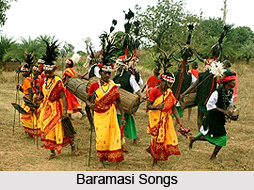 Baramasi Songs, originating from the Indian folk tradition and prominently found in West Bengal, represent a musical expression of the Barahmasa poetic genre. These songs, reflecting the longing of women for their absent lovers or husbands, intricately weave emotional narratives amidst the changing seasons and ritualistic events. The progression of months according to the Hindu lunar calendar forms a foundational aspect of this genre, encapsulating the joys and sorrows experienced by village women throughout the twelve months of the Bengali year.
Baramasi Songs, originating from the Indian folk tradition and prominently found in West Bengal, represent a musical expression of the Barahmasa poetic genre. These songs, reflecting the longing of women for their absent lovers or husbands, intricately weave emotional narratives amidst the changing seasons and ritualistic events. The progression of months according to the Hindu lunar calendar forms a foundational aspect of this genre, encapsulating the joys and sorrows experienced by village women throughout the twelve months of the Bengali year.
Baramasi Songs in Bengali Literature
Baramasi Songs hold significance in Bengali literature, particularly in devotional works such as Mangal-Kavya. Chandravati`s adaptation of the Ramayana features Sita recollecting her experiences with Rama over the course of a year, incorporating elements of the baromasi tradition. This literary form serves as a conduit for expressing devotion and emotions, enriching the cultural tapestry of Bengal with its thematic depth and narrative intricacies.
Themes of Baramasi Songs
Baramasi, going by the sequence of the months, means narratives representing twelve months. For example, the sky is clear and transparent in the early spring, foggy in winter, and full of clouds in summer. Different seasons produce different consequences on the human system, on the paddy-fields, and on the variegated colourful flowers and leaves of trees with which the villages abound. So just like month, life changes and nature disports herself on the stage of this beautiful land through the twelve months of the year. Descriptions of the twelve months include nature, festivals, cropping, weather and other similar environment in details. Therefore, the music developed is more or less a recitative character of Pancali. The lead character of the Baramasi songs is usually a deserted wife who addresses the image of her heart`s lord, narrating him her joys and sorrows in every month of the year.
Concept of Baramasi Songs
Baramasi songs, deeply ingrained in Bengali culture, serve as poignant reflections of societal narratives and traditional events. These compositions intertwine mythological tales, love stories, and agricultural experiences, embodying both literary and social significance. Often referred to as `work songs`, they accompany the laborious tasks of female farmers, offering solace amidst the toil of fieldwork. Remarkably, these songs are devoid of musical accompaniment, their mournful tunes resonating with the sorrow of separation. As valuable literary and social documents, Baramasi songs contribute to the preservation of cultural heritage while encapsulating the multifaceted aspects of Bengali life and tradition.
Types of Baramasi Songs
Two prevalent types of Baramasi songs are Sita`s Baramasi and Nila`s Baramasi. Both narratives share similarities in their themes. Sita`s Baramasi, for instance, portrays Sita lamenting her separation from Ramachandra during the month of Asadh. She recounts the heavy rains of the season and expresses her longing to reunite with her husband. This excerpt reflects her sorrow. These songs serve as cultural artifacts, embodying emotional depth and traditional storytelling.
The works of 16th-century poet Mukundadas named "Kalketu Upakhyan" mentions a poignant narrative known as Phullarar Baramasi. This section delves into the enduring hardships faced by Phullara over the span of twelve months, offering a rich exploration of human resilience amidst adversity.
Popularity of Baramasi Songs
Baramasi, as a genre, is extant in Assamese as Baramahigift. Bichhedi of Bhatiali group is often given a colour of Baramasi or Baramasya. The theme is commonly utilized in a few ballad songs in Bhatiali of narrative type (panchali). Song common in Bhaoaia groups is also sung by Baudias of Cooch-Behar and peasants of Jalpaiguri. Song begins in late autumn coinciding with harvesting or from the month of Falgun (spring). The woman speaks in first person about the association of her husband who is away. In this connection, one is reminded of the Baramasi of Fullara from medieval literature. Some other varieties are also available in Mangal Kavyas; Behula in Manasamangal exposes an Astamash (details of eight months) expression. Dussan Zbavitelo of Czechoslovakia has worked on literary tradition of Baramasi.




















